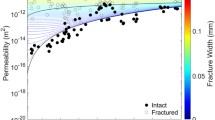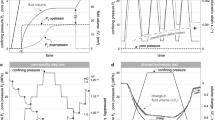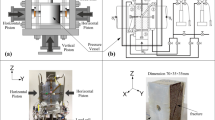Abstract
Permeability exerts significant control over the development of pore pressure excess in the crust, and it is a physical quantity sensitively dependent on the pore structure and stress state. In many applications, the relation between permeability and effective mean stress is assumed to be exponential and that between permeability and porosity is assumed to be a power law, so that the pressure sensitivity of permeability is characterized by the coefficient γ and the porosity sensitivity by the exponent α. In this study, we investigate experimentally the dependence of permeability on pressure and porosity in five sandstones with porosities ranging from 14% to 35% and we review published experimental data on intact rocks, unconsolidated materials and rock fractures. The laboratory data show that the pressure and porosity sensitivities differ significantly for different compaction mechanisms, but for a given compaction mechanism, the data can often be approximated by the empirical relations. The permeabilities of tight rocks and rock joints show relatively high pressure sensitivity and low porosity sensitivity. A wide range of values for α and γ have been observed in relation to the mechanical compaction of porous rocks, sand and fault gouge, whereas the porosity sensitivity for chemical compaction processes is often observed to be given by α≈3. We show that since the ratio γ/α corresponds to the pore compressibility, the different dependences of permeability on porosity and pressure are related to the pore structure and its compressibility. Guided by the laboratory data, we conduct numerical simulations on the development of pore pressure in crustal tectonic settings according to the models ofWalder andNur (1984) andRice (1992). Laboratory data suggest that the pressure sensitivity of fault gouge is relatively low, and to maintain pore pressure at close to the lithostatic value in the Rice model, a relatively high influx of fluid from below the seismogenic layer is necessary. The fluid may be injected as vertically propagating pressure pulses into the seismogenic system, andRice's (1992) critical condition for the existence of solitary wave is shown to be equivalent to α>1, which is satisfied by most geologic materials in the laboratory. Laboratory data suggest that the porosity sensitivity is relatively high when the permeability is reduced by a coupled mechanical and chemical compaction process. This implies that in a crustal layer, pore pressure may be generated more efficiently than cases studied byWalder andNur (1984) who assumed a relatively low porosity sensitivity of α=2.
Similar content being viewed by others
References
Arch, J., andMaltman, A. (1990),Anisotropic Permeability and Tortuosity in Deformed Wet Sediments, J. Geophys. Res.95, 9035–9045.
Bangs, N., Westbrook, G. K., Ladd, J. W., andBuhl, P. (1990),Seismic Velocities from the Barbados Ridge Complex and Indications of High Pore Pressures in an Accretionary Complex, J. Geophys. Res.95, 8767–8782.
Bernabé, Y. (1986),The Effective Pressure Law for Permeability in Chelmsford Granite and Barre Granite, Int. J. Rock Mech. Min. Sci and Geomech. Abst.23, 267–275.
Bernabé, Y. (1987),A Wide Range Permeameter for Use in Rock Physics, Int. J. Rock Mech. Min. Sci. and Geomech. Abst.24, 309–315.
Bernabé, Y. (1991),Pore Geometry and Pressure Dependence of the Transport Properties in Sandstones, Geophys.56, 436–446.
Bernabé, Y., Brace, W. F., andEvans, B. (1982),Permeability, Porosity and Pore Geometry of Hot Pressed Calcite, Mech. Mat.1, 173–183.
Blanpied, M. L., Lockner, D. A., andByerlee, J. D. (1992),An Earthquake Mechanism Based on Rapid Sealing of Fault, Nature358, 574–576.
Bourbié, T., andZinzsner, B. (1985),Hydraulic and Acoustic Properties as a Function of Porosity in Fontainebleau Sandstone, J. Geophys. Res.90, 11524–11532.
Brace, W. F. (1965),Some New Measurements of Linear Compressibility of Rocks, J. Geophys. Res.70, 391–398.
Brace, W. F. (1978a),Volume Change During Fracture and Frictional Sliding: A Review, Pure and Appl. Geophys.116, 603–614.
Brace, W. F. (1978b),A Note on Permeability Changes in Geologic Materials due to Stress, Pure and Appl. Geophys.116, 627–633.
Brace, W. F. (1980),Permeability of Crystalline and Argillaceous Rocks, Int. J. Rock Mech. Min. Sci. and Geomech. Abst.17, 241–251.
Brace, W. F., Orange, A. S., andMadden, T. R. (1965),The Effect of Pressure on the Electrical Resistivity of Water Saturated Crystalline Rocks, J. Geophys. Res.70, 5669–5678.
Brace, W. F., Walsh, J. B., andFrangos, W. T. (1968),Permeability of Granite under High Pressure, J. Geophys. Res.73, 2225–2236.
Bredehoeft, J. D., andHanshaw, B. B. (1968),On the Maintenance of Anomalous Fluid Pressures. I Thick Sedimentary Sequences, Geol. Soc. Am. Bull.79, 1097–1106.
Bredehoeft, J. D., andNorton, D. L.,The Role of Fluids in Crustal Processes (National Academy Press 1990), 170 pp.
Bruno, M. S., Bovberg, C. A., andNakagawa, F. M.,Anisotropic stress influence on the permeability of weakly-cemented sandstones. InRock as a Multidisciplinary Science, Proc. 32nd US Rock Mech. Symp. (ed. J. C. Roegiers) (Balkema 1991), pp. 375–383.
Byerlee, J. (1990),Friction, Overpressure and Fault Normal Compression, Geophys. Res. Lett.17, 2109–2112.
Byrne, T., andFisher, D. (1990),Evidence for a Weak and Overpressured Décollement beneath Sediment-dominated Accretionary Prisms, J. Geophys. Res.95, 9081–9097.
Coyner, K. B. (1984),Effect of Stress, Pore Pressure, and Pore Fluids on Bulk Strain, Velocity, and Permeability in Rocks, Ph.D. thesis, Stanford University.
David, C. (1991),La perméabilité et la conductivité électrique des roches dans la croûte: Expériences en laboratoire et modèles théoriques, Ph.D. thesis, Univ. Strasbourg, France.
David, C. (1993),Geometry of Flow Path for Fluid Transport in Rocks, J. Geophys. Res.98, 12267–12278.
David, C., andDarot, M. (1989), Permeability and conductivity of sandstones. In Proc. Symp.Rock at Great Depth (eds. Maury, V., and Fourmaintraux, D.) (Balkema 1989) Vol. 1, pp. 203–209.
Davis, D. M., Suppe, J., andDahlen, F. A. (1983),Mechanics of Fold and Thrust Belts and Accretionary Wedges, J. Geophys. Res.88, 1153–1172.
Debschutz, W., Kruckel, U., andSchopper, J. R. (1989), Effects of geostatic stress and pore pressure on the Klinkenberg permeability factor and other fluid flow parameters. In Proc. Symp.Rock at Great Depth (eds. Maury, V., and Fourmaintraux, D.) (Balkema 1989) Vol. 1 pp. 179–186.
Dey, T. N. (1986),Permeability and Electrical Conductivity Changes due to Hydrostatic Stress Cycling of Berea and Muddy J Sandstone, J. Geophys. Res.91, 763–766.
Etheridge, M. A., Wall, V. J., Cox, S. F., andVernon, R. H. (1984),High Fluid Pressures during Regional Metamorphism and Deformation: Implications for Mass Transport and Deformation Mechanisms, J. Geophys. Res.89, 4344–4358.
Fischer, G., andPaterson, M. S.,Measurements of permeability and storage capacity in rocks during deformation at high temperature and pressure. InFault Mechanics and Transport Properties of Rocks (eds. Evans, B., and Wong, T.-f.) (Academic Press 1992) pp. 213–252.
Freeze, R. A., andCherry, J. A.,Groundwater (Prentice-Hall, NJ 1979) 604 pp.
Fyfe, W. F., Price, N. J., andThompson, A. B.,Fluids in the Earth's Crust (Elsevier, NY 1978) 383 pp.
Gavrilenko, P., andGueguen, Y. (1993),Fluid Overpressures and Pressure Solution in the Crust, Tectonophys.217, 91–110.
Hadley, K. (1976),Comparison of Calculated and Observed Crack Densities and Seismic Velocities in Westerly Granite, J. Geophys. Res.81, 3484–3494.
Hubbert, M. K., andRubey, W. W. (1959),Role of Fluid Pressure in the Mechanics of Overthrust Faulting, I. Mechanics of Fluid-filled Porous Solids and its Implications to Overthrust Faulting, Geol. Soc. Am Bull.70, 115–166.
Huenges, E., andWill, G.,Permeability, bulk modulus and complex resistivity in crystalline rocks. InFluid Movements, Element Transport and the Composition of the Deep Crust, NATO ASI, C281 (Kluwer, Dordrecht 1989) pp. 361–375.
Karig, D. E. (1990),Experimental and observational constraints on the mechanical behavior in the toes of accretionary prisms. InDeformation Mechanisms, Rheology and Tectonics (eds. Knipe, R. J., and Rutter, E. H.) Geol. Soc. Sp. Pub.54, 383–398.
Kranz, R. L., Frankel, A. D., Engelder, T., andScholz, C. H. (1979),The Permeability of Whole and Jointed Barre Granite, Int. J. Roch Mech. Min. Sci.16, 225–235.
Lachenbruch, A. H., andSass, J. H. (1980),Heat Flow and Energetics of the San Andreas Fault Zone, J. Geophys. Res.85, 6185–6222.
Lachenbruch, A. H., andSass, J. H. (1992),Heat Flow from Cajon Pass, Fault Strength, and Tectonic Implications, J. Geophys. Res.97, 4995–5015.
Lambe, T. W., andWhitman, R. V.,Soil Mechanics (John Wiley, New York 1969), 553 pp.
Lockner, D. A. (1990),Modeling of Brittle Failure and Comparisons to Laboratory Experiments, Ph.D. thesis, MIT.
Moore, J. C. (1989),Tectonics and Hydrogeology of Accretionary Prisms: Role of the Décollement Zone, J. Struct. Geol.11, 95–106.
Morrow, C., Lockner, D., Hickman, S., Rusanov, M., andRöckel, T. (1994),Effects of Lithology and Depth on the Permeability of Core Samples from the Kola and KTB Drillholes, J. Geophys. Res.99, 7263–7274.
Morrow, C. A., Shi, L. Q., andByerlee, J. D. (1984),Permeability of Fault Gouge under Confining Pressure and Shear Stress, J. Geophys. Res.99, 3193–3200.
Morrow, C. A., Zhang, B., andByerlee, J. D. (1986),Effective Pressure Law for Permeability of Westerly Granite under Cyclic Loading, J. Geophys. Res.91, 3870–3876.
Nelson, P. H., andAnderson, L. A. (1992),Physical Properties of Ash Flow Tuff from Yucca Mountain, Nevada, J. Geophys. Res.97, 6823–6841.
Nur, A., andWalder, J.,Hydraulic pulses in the earth's crust. InFault Mechanics and Transport Properties of Rocks (eds. Evans, B., and Wong, T.-f.) (Academic Press, San Diego 1992), pp. 461–474.
Pratt, H. R., Black, A. D., Brace, W. F., andSwolfs, H. (1977),Elastic and Transport Properties of an in situ Jointed Granite, Int. J. Rock Mech. Min. Sci. and Geomech. Abstr.14, 35–45.
Raven, K. G., andGalf, J. E. (1985),Water Flow in a Natural Rock Fracture as a Function of Stress and Sample Size, Int. J. Rock Mech. Min. Sci.22, 251–261.
Rice, J. R. (1992),Fault stress states, pore pressure distributions, and the weakness of the San Andreas Fault. InFault Mechanics and Transport Properties of Rocks (eds. Evans, B., and Wong, T.-f.) (Academic Press 1992) pp. 475–503.
Riepe, L., Sachs, W., andSchopper, J. R. (1983),Pressure Effects on Permeability, 8th Eurp. Form. Eval. Symp. Trans., London, Paper B, 1–24.
Torgersen, T. (1991),Crustal-scale Fluid Transport: Magnitude and Mechanisms, Geophys. Res. Lett.18, 917–918.
Trimmer, D., Bonner, B., Heard, H. C., andDuba, A. (1980),Effect of Pressure and Stress on Water Transport in Intact and Fractured Gabbro and Granite, J. Geophys. Res.85, 7059–7071.
Vrolijk, P., Myers, G., andMoore, J. C. (1988),Warm Fluid Migration along Tectonic Melanges in the Kodiak Accretionary Complex, Alaska, J. Geophys. Res.93, 10313–10324.
Walder, J., andNur, A. (1984),Porosity Reduction and Crustal Pore Pressure Development, J. Geophys. Res.89, 11539–11548.
Walsh, J. B. (1965),The Effect of Cracks on the Compressibility of Rocks, J. Geophys. Res.70, 381–389.
Walsh, J. B. (1981),Effect of Pore Pressure and Confining Pressure on Fracture Permeability, Int. J. Rock Mech. Min. Sci.18, 429–435.
Walsh, J. B., andGrosenbaugh, M. A. (1979),A New Model for Analyzing the Effect of Fractures on Compressibility, J. Geophys. Res.84, 3532–3536.
Wong, P.-z., Koplik, J., andTomanic, J. P. (1984),Conductivity and Permeability of Rocks, Phys. Rev.B 30, 6606–6614.
Wong, T.-f., Fredrich, J. T., andGwanmesia, G. B. (1989),Crack Aperture Statistics and Pore Space Fractal Geometry of Westerly Granite and Rutland Quartzite: Implications for an Elastic Contact Model of Rock Compressibility, J. Geophys. Res.94, 10267–10278.
Yale, D. P. (1984),Network Modelling of Flow, Storage and Deformation in Porous Rocks, Ph.D. thesis, Stanford University, Calif.
Zhang, J., Wong, T.-f., andDavis, D. M. (1990a),Micromechanics of Pressure-induced Grain Crushing in Porous Rocks, J. Geophys. Res.95, 341–352.
Zhang, J., Wong, T.-f., andDavis, D. M.,High pressure embrittlement and shear-enhanced compaction in Berea sandstone: Acoustic emission measurement and microstructural observation. InRock Mechanics Contributions and Challenges, Proceedings of the 31st U.S. Rock Mechanics Symposium (eds. Hustrulid, W. A., and Johnson, G. A.) (Balkema 1990b) pp. 653–660.
Zhang, J., Davis, D. M., andWong, T.-f. (1993),Failure modes on tuff samples from Leg 131 in the Nankai accretionary wedge. InProceedings of the Ocean Drilling Program, Scientific Results, Vol. 131, 275–281.
Zhang, S., Cox, S. F., andPaterson, M. S. (1994),Porosity and Permeability Evolution during Hot Isostatic Pressing of Calcite Aggregates, J. Geophys. Res. in press.
Zhu, W., David, C., andWong, T.-f. (1993),Permeability Reduction Induced by Pore Shrinkage and Connectivity Loss: Microstructural Observations and Percolation Modeling (Abstract), Trans. Amer. Geophys. Union, EOS74, 293.
Zoback, M. D., andByerlee, J. D. (1975),Permeability and Effective Stress, Am. Assoc. Pet. Geol. Bull.59, 154–158.
Zoback, M. D., andByerlee, J. D. (1976),Effect of High-pressure Deformation on Permeability of Ottawa Sand, Am. Assoc. Pet. Geol. Bull.60, 1531–1542.
Zoback, M. D., Zoback, M. L., Mount, V. S., Suppe, J., Eaton, J. P., Healy, J. H., Oppenheimer, D., Reasenberg, P., Jones, L., Raleigh, C. B., Wong, I. G., Scotti, O., andWentworth, C. (1987),New Evidence on the State of Stress of the San Andreas Fault System, Science238, 1105–1111.
Author information
Authors and Affiliations
Rights and permissions
About this article
Cite this article
David, C., Wong, TF., Zhu, W. et al. Laboratory measurement of compaction-induced permeability change in porous rocks: Implications for the generation and maintenance of pore pressure excess in the crust. PAGEOPH 143, 425–456 (1994). https://doi.org/10.1007/BF00874337
Received:
Revised:
Accepted:
Issue Date:
DOI: https://doi.org/10.1007/BF00874337




